Vol 5 No. 24 TROPIC LIGHTNING NEWS June 22, 1970
Index
Supplies ‘a doctor would use’
Warriors Fight to Cache
By Sp4 ED TOULOUSE
WEST OF THE FISH HOOK, Cambodia - It was a difficult spot for the
25th Infantry Division’s “Warriors” to be in - foliage was dense, and the
enemy was well situated.
But by maximum use of their own fire power and with well-aimed
artillery and air support, the 2nd Battalion, 12th Infantry, called all the
punches in the victory that led them to fifty tons of rice and 4,000 pounds of
medical supplies.
“We were going through some thick stuff and I had just pushed
aside a branch when the enemy opened fire from a hole,” said 2nd Platoon
pointman, Sergeant Joseph R. Moore, from Fairhope, Ala.
“I was so close that I could see the red muzzle-flash of the
weapon.” he continued. “I hit the ground faster than I ever thought
possible. The rest of the guys immediately opened up, giving me time to
get to cover.”
When the Americans had drawn back sufficiently, artillery, then
Cobras were called in. The combined firepower quickly convinced the enemy
to retreat. They left behind three dead.
Quickly combing the area, the Warriors found at several different
sites slightly more than 100,000 pounds of rice. The cache - typical of
most of those found in Cambodia - was discovered above ground, in large
rectangular piles covered with a greenish plastic.
Along with the rice, the GIs found 4,000 pounds of medical
supplies, including drugs and medicine, many rolls of gauze and bandage and an
array of sophisticated medical instruments.
“Some of this stuff, only a doctor could use,” said medic,
Specialist 4 Joseph Lundy, from Costa, N.M.
Although at this point the operation was clearly a success, it was
still incomplete. There remained the task of removing the large number of
220-pound rice bags.
Tomahawks’ Use 1-Man MEDCAP
By SGT BILL OBERHOLZER
SOUTHWEST OF MEMUT, Cambodia - The 25th Division’s 4th Battalion,
23rd Infantry, “Tomahawks,” have added a twist to their concept of MEDCAP in
adopting it to use in Cambodia - the one-man MEDCAP.
First. Lieutenant Robert Anderson, of Youngstown, Ohio, a Medical
Service Corps Officer, is the only medical person present at the Tomahawks’
Cambodia MEDCAPs.
“I keep my medics at the fire base,” replied Anderson to a
question about the nature of the new MEDCAPS. “I feel they may be needed
there so I’ve been handling the MEDCAPS alone.”
Accompanied by men from the battalion Psychological Operations
Team, Anderson tries to reach at least two villages a day.
“I’ve treated 80 to 100 people in some villages,” he said.
“They’re very receptive, and they often give me pineapples as gifts.”
The team moves in jeeps. Although the terrain is rough and
they have often received sniper fire, they continue to visit villages,
simultaneously helping the natives and gaining tactical information -
information which should help make easier the Tomahawks’ task in Cambodia.
| OVER THE BORDER - Flying into Cambodia, bulging with “Golden Dragons” of the 2nd Battalion, 14th Infantry, “Crusaders” of the 187th Assault Helicopter Company swoop toward the smoke of battle to insert US troops. (Photo by SGT Dan Delaney) | 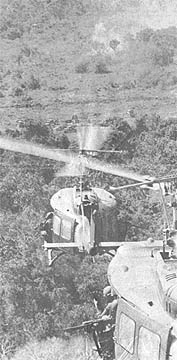 |
‘We almost ran over it’
Rider Eases into Cache
By SGT BILL OBERHOLZER
SOUTHWEST OF MEMOT, Cambodia - The combination of a fallen tree in
the middle of a path and a not so “Easy Rider” led the 4th Battalion (Mech.)
23rd Infantry, to a large enemy supply cache in Cambodia recently.
Operating about five miles inside Cambodia, the 4/23rd
“Tomahawks” Bravo Company was conducting a sweep through heavily vegetated
area. The armored personnel carriers were in the lead, followed by ground
troops searching the flattened paths.
During the sweep, an APC named “Easy Rider” challenged a log
and lost. As the downed APC was being moved by a cable, her driver,
Specialist 4 Larry Key, of La Puente, Calif., spotted a hootch. “We
almost ran over it,” quipped Key.
The Tomahawks quickly moved in and discovered a small enemy base
camp. There, they found a storehouse which contained 23 bags with 250
pounds of rice in each bag, 400 feet of commo wire, five Chi-Com claymore mines,
five pounds of clothing, 2,000 AK rounds and miscellaneous items. There
were also ten hootches, bunkers, a school, two mess halls and living quarters in
the complex.
“It looked like there had been enemy activity as recently as two
days ago,” said Specialist 4 Ray Harcourt, an RTO (radio telephone operator),
from Cincinnati.
“The items that were found,” he added, “led me to believe
that the camp was set up for more than a company-sized unit.”
After removing the supplies, the Tomahawks destroyed the complex.
‘3-Duece’ Upends Charlie’s Ambush
By Sp4 HENRY G. ZUKOWSKI
SOUTH OF THE DOG’S FACE, Cambodia - Reversing the intent of an
enemy ambush, men of the 2nd Battalion (Mech.), 22nd Infantry, Scout Platoon
recently killed five enemy in action near here.
The morning mist from the night rain was still in the air as the
“Triple Deuce” Scout Platoon moved out of the battalion night laager
position with their armored personnel carriers on a search and destiny mission.
“Our element led the tracked formation down a rough trail along a
heavily wooded area,” said Specialist 4 Tim Albright, of Lawrenceburgh, Ind.,
a rifleman.
“All of a sudden, a barrage of small arms and RPG fire from both
sides of the trail began to crack around us. We turned our APCs around and
blasted away with our .50 caliber and M-60 machine guns.”
Soon, artillery support called in from Delta Battery, 3rd
Battalion, 13th Artillery, was pounding away with “eight inchers” on the
estimated platoon-size enemy positions.
“The artillery support kept the enemy’s head down, enabling us to
gain fire superiority,” added Albright.
Besides the five enemy bodies, the GIs found NVA webgear and
supplies.
American casualties were light.
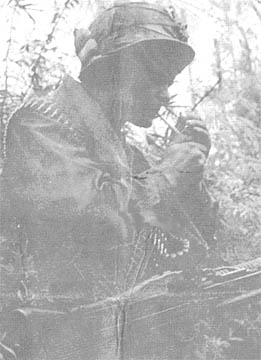 |
A MOMENT'S REST - During a short break while on a rif with the Recon Platoon of the 1st Battalion (Mech.), 5th Infantry, Private First Class Roger Wood of Seward, Neb., pauses before moving on against the enemy. (Photo by SP4 Rich Fitzpatrick) |
Page 2 TROPIC LIGHTNING NEWS June 22, 1970
Decorated
| SILVER STAR | |
| CPT Jerry D. Bateman, Co C, 2d
Bn, 27th Inf CPT Charles E. Criswell, Co B, 2d Bn, 27th Inf 2LT Dennis Heitner, Co B, 2d Bn, 27th Inf |
2LT Steven J. Peterson, Co B, 2d Bn, 27th Inf PFC Paul D. Francois, Co A, 2d Bn, 34th Armor |
| DISTINGUISHED FLYING CROSS |
|
| LTC Lewis W. Wright,
HHB, 2d Bn, 27th Inf WOl John S. Bourquin, Co A, 25th Avn Bn WOl Donald H. Lish, Co A, 25th Avn Bn |
WOl Edward L. Mortimer, Co B, 25th Avn Bn WOl Joseph C. Wasmond, Co A, 25th Avn Bn WO1 John M. Wilson, Co A, 25th Avn Bn |
| SOLDIER'S MEDAL |
|
| 1LT Gerald D. Marlowe,
HHC, 2d Bn 34th Armor 1LT Michael P. Pate, Co D, 2d Bn, 34th Armor SFC Arthur Wooters, Co D, 2d Bn, 34th Armor |
SGT Alan T. Carter, HHC, 2d Bn, Armor SP4 Claude N. West, Co D, 2d Bn, 34th Armor |
| BRONZE STAR |
|
| MAJ Bobby L. Rice,
HHSB, 1st Bn, 8th Fld Arty CPT James H. Chapman, HHSB, 1st Bn, 8th Fld Arty CPT John Michell, Co A, 2d Bn, 27th Inf CPT William F. O’Brien, HHSB, 1st Bn, 8th Fld Arty CPT Arthur Schultz, C Trp, 3d Sqdn, 4th Cav CPT Marvin L. Tieman, Co A, 2d Bn, 34th Armor 1LT Thomas J. Morgan, C Trp, 3d Sqdn, 4th Cav 1LT Carrol R. Rich, HHC, 2d Bn, 34th Armor 1LT Cambell W. Winkler, Co B, 2d Bn, 34th Armor 2LT Cazimer J. Glownia, Co A, 2d Bn, 34th Armor 2LT Gregory L. Soloman, Co C, 2d Bn, 27th Inf SFC Joseph L. Cameron, B Trp,, 3d Sqdn, 4th Cav SFC Edward L. Mauro, HHB, 1st Bn, 8th Fld Arty SSG Billy D. Browning, HHB, 1st Bn, 8th Fld Arty SSG Everett E. Longland, C Trp, 3rd Sqdn, 4th Cav SSG Leon Moore HHC, 2d Bn, 34th Armor SSG James C. Smith, HHC, 2d Bn, 34th Armor SSG Leslie G. Snider, HHB, 1st Bn, 8th Fld Arty PSG Mike Kromoff, HHC, 2d Bn, 34th Armor SGT Robert Callery, Co B, 2d Bn, 34th Armor SGT Alan T. Carter, HHC, 2d Bn,134th Armor SGT James J. Davis, Co B 2d Bn, 34th Armor SGT Michael W. English, Co B, 65th Avn Bn SGT Donald A. Jordon, HHC, 2d Bn, 34th Armor SGT Eugene G. Poole, Co C, 2d Bn, 12th Inf SGT Richard D. Ramsey, Co C, 2d Bn, 12th Inf SGT Thomas G. Sines, Co E, 2d Bn, 12th Inf SP5 Curtis O. Austin, Co.A, 2d Bn, 34th Armor SP5 William A. Moore, Co B, 2d Bn, 34th Armor SP5 William W. Skinner, Co B, 65th Eng Bn |
SP5 Kenneth W. Stewart, Co B, 2d Bn, 34th Armor CSM Joseph Chickini, HHB, Div Arty SFC Charles A. Forse, Co B, 2d Bn, 27th Inf SSG Melvin R. Barnes, Co B, 1st Bn, 5th Inf SGT James H. Benton, Co C, 1st Bn, 5th Inf SGT Richard E. Galas, Co A, 1st Bn, 5th Inf SGT Walter J. Griffin, Co D, 2d Bn, 14th Inf SGT Adrian R. Lehde, HHC, 1st Bde SP5 Jimmy R. Bledsoe, Co D, 1st Bn, 5th Inf SP5 Eric A. Johnsen, HHC, 1st Bde SP4 Garel L. Baker, Co A, 2d Bn, 12th Inf SP4 Michael D. Berness, Co C, 1st Bn, 5th Inf SP4 Ralph Brunswick, Co A, 1st Bn, 5th Inf SP4 Robert A. Cogdill, Co C, 1st Bn, 5th Inf SP4 Lewis J. Eggert Jr, HHC, 1st Bde SP4 John Gardner, Co A, 1st Bn, 5th Inf SP4 Gregg L. Fairbank, Co A, 2d Bn, 12th Inf SP4 Michael W. McGrane, HHC, 1st Bde SP4 Leroy K. McKinney, Co A, 1st Bn, 5th Inf SP4 Henry W. Morse, Co A, 1st Bn, 5th Inf SP4 Richard F. Nix, Co A, 1st Bn, 5th Inf SP4 Bruce H. Scattergood, Co B, 2d Bn, 27th Inf SP4 Duane T. Schindler, Co B, 2d Bn, 27th Inf SP4 Ronald Sevffert, Co A, 1st Bn, 5th Inf SP4 David E. Will, Co A, 2d B, 12th Inf SP4 John W. Witter, Co B, 2d Bn, 27th Inf PFC Halie Caldwell, Co A, 1st Bn, 5th Inf PFC Frederick Erben, Co B, 2d Pn, 27th Inf PFC Dallas E. Fairley, Co A, 1st Bn, 5th Inf |
Vehicle Safety
Each Soldier’s Concern
By SP4 DAVID MACLARY
Despite the stress put upon the individual soldier’s role in
vehicle safety and maintenance measures, many careless accidents still happen.
Two recent ones show the importance of watching out for the
passenger aboard the vehicle.
One accident involved a two-and-one-half ton truck going from Fire
Support Base Kien to Dau Tieng base camp. A private first class was seated
on the floor of the truck with his back against the upraised tail gate. As
the truck (traveling at a moderate rate of speed) hit a large dip in the road,
the tailgate became unlatched causing the soldier to fall backwards.
Behind the truck was an attached water trailer. The PFC fell onto
the tongue of the trailer and rolled under the wheel. The consequence?
A compound fracture of the lower right leg.
Had the driver of the vehicle checked his passenger to make sure
his seating was secure this accident could have been prevented.
In another incident, a PFC at Fire Support Base Rainier was
standing on the running board of a two-and-one-half ton truck giving directions
to the driver. When the driver shifted gears, the truck lurched throwing
the PFC to the ground. He was killed when his head was crushed by the left
rear set of dual tires.
A little more attention on the part of the PFC might have prevented
this fatality.
DoD Alters Travel Aid
WASHINGTON (ANF) - Under certain conditions, round trip
transportation at government expense may now be granted to two members of the
family of a serviceman or Department of Defense (DOD) civilian employee who is
hospitalized outside of the Continental United States (CONUS) in a ‘very
seriously ill or injured condition.
Prior to a recent DOD policy change, only one family member could
make the journey.
The following guidelines now apply:
-The two travelers may include the wife, mother, father, brothers
or sisters of the patient. Primary next of kin decides “who goes.”
-Travel may be authorized only when considered essential to the
patients welfare by the attending physician and appropriate hospital commander.
-Once the visit is approved, government transportation will be
provided from an aerial port of embarkation (APOE) to the overseas point nearest
the hospital and return. All other trip expenses (such as travel to the
APOE, food and lodging) must be borne by family members.
-Authorization also may apply in reverse for a serviceman
hospitalized in CONUS whose family resides outside the country.
This policy revision, announced in Department of the Army Message
132112Z April 1970, will be reflected in the next published changes to Army
Regulations 59-12 and 600-10.
 |
THE FORMER CHIEF OF STAFF of the 25th Infantry Division, Colonel James M. Connell of Titusville, Pa., recently replaced Colonel Olin E. Smith as commander of the division’s third brigade. |
Tropic Lightning Tots
The Commanding General Welcomes
The Following Tropic Lightning Tots
To The 25th Infantry Division – As
Reported By The American Red Cross.
Born To:
| May 23 SP4 Larry R. Farmer, C Btry, 2nd Bn, 32nd Arty, girl May 24 SGT Gary E. Berg, C Co, 4th Bn, 23rd Inf, boy May 27 SP5 Ronald L. Dicks, HHC, 25th Inf Div, girl SP4 Harry R. Harbison, HHC, 65th Engrs, boy SP4 Thomas F. McDermott, C Co, 4th Bn, 9th Inf, boy May 29 SP4 Roger D. Burleson, C Co, 588th Engrs, girl PFC Ray Degado, A Co, 1st Bn, 5th Inf, girl |
June 1 SP5 Robert Shell, 116th AH Co, boy WO1 William R. Duncan, HHD, 125th Sig Bn, boy SP4 David L. Ruffin, HHC, 25th Inf Div, boy PFC George L. Auker, A Co, 125th Sig Bn, boy June 2 MAJ David A. Dunn, Adv Team 99, boy June 3 CPT Roman L. Millett, D Trp, 3rd Bn, 4th Cav, girl SP4 Gary S. Kean, C Btry, 3rd Bn, 13th Arty, boy |
The TROPIC LIGHTNING NEWS is an authorized publication of the 25th Infantry Division. It is published weekly for all division units in the Republic of Vietnam by the Information Office, 25th Infantry Division, APO San Francisco 96225. American Forces Press Service and Army News Feature materials are used. Views and opinions expressed are not necessarily those of the Department of the Army. Printed in Tokyo, Japan, by Pacific Stars and Stripes.
MG Edward Bautz, Jr . . . . Commanding General
MAJ Warren J. Field . . . Information Officer
1LT John Caspari . . . . . . . Officer-in-Charge
SSG Stephen F. Veroczi . . NCOIC
SP4 Charles C. Self . . Editor
SP5 Gary D. Sciortino . . . Assistant Editor
SP4 Joseph V. Kocian . . . Production Supervisor
BATTALION CORRESPONDENTS
|
SGT Bill Oberholzer SP4 Robert Caplan SGT Mike Keyster SP4 Tom Benn SP4 Brad Yaeger SP4 Frank Rezzonico SP4 Frank Salerno SP4 Henry Zukowski, Jr SP4 Brian Flanherty PFC Rob Lato SP4 Greg Duncan SP4 Ray Byrne |
4/23 4/23 4/23 7/11 1/27 1/27 2/22 2/22 3/22 2/27 2/27 2/14 |
SP4 Rich Erickson SP4 Ed Toulouse SP4 Doug Sainsbury SGT Mike Conroy SGT William E. Zarrett SP4 Lawrence Merritt SP4 Rich Fitzpatrick SP4 Ken Barron SP4 George Graham SP5 Tom Watson SP4 Willaim McGown PFC James B. Stoup |
2/14 2/12 2/77 3/4 4/9 4/9 1/5 1/8 269th 725th Divarty 65th |
Page 3 TROPIC LIGHTNING NEWS June 22, 1970
|
 |
|
Story and Photos |
DAU TIENG -- “Welcome back. Good to see you.
Drop your gear. Relax for a while. Grab a soda, it’s good and
cold.”
The men of the 3rd Battalion, 22nd Infantry, were home from
Cambodia -- back in Vietnam -- dog-tired but happy. Theirs had been one of
the first units into Cambodia and now they, like others, were back.
“It was rough.”
“Vietnam never looked so good.”
As they climbed off the C-123 cargo planes, the 25th Division Band
serenaded them. A Red Cross “Donut Dolly” and two Service Club girls
welcomed them with Kool-Aid and smiles. And everyone congratulated them.
“The red ants were a bitch.”
“We took fire at the first ‘friendly’ village we came to.”
Soon the men piled onto trucks and were taken from the airstrip to
the main rest area where hot chow, cool showers and soft beds awaited them.
“I never thought I’d be glad to see Vietnam.”
Page 4-5 TROPIC LIGHTNING NEWS June 22, 1970
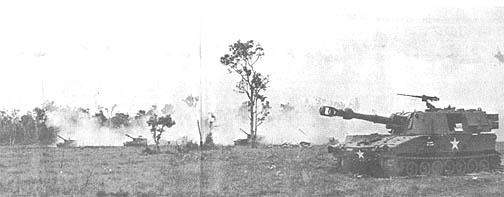 |
| Batteries like this one fired thousands of rounds into former enemy sanctuaries to end enemy hopes of a buildup after US forces withdraw. |
First Over Border, Largest Recently
25th Stages Arty Raid into Cambodia
By SP4 BILL MC GOWN
THIEN NGON – A recent “turkey shoot” – the largest
artillery assault of its kind recently – by 25th Division and II Field Force
artillery destroyed the Communists’ hopes for rapid rebuilding after the
withdrawal of American ground troops from Cambodia on June 30th.
The arty attack showed that the extensive bunker complexes of the
Viet Cong and NVA along the Cambodian border can no longer be considered
sanctuaries.
The plan for the surprise attack was initiated by Colonel H.A.
Buzzett, commanding officer of 25th Division Artillery, and was based on latest
intelligence reports of enemy activity.
The main target of the arty barrage was the
suspected site of the 9th NVA Division base camp, although fire also was
directed on areas of generally heavy enemy trail activity.
For the operation, 16 howitzers were road marched to a location
three and one-half miles northwest of Thien Ngon, while an additional two 175mm
howitzers from C Battery, 2nd Battalion, 32nd Artillery, (II FF) fired from
their position at Fire Support Base Blaster.
At 10 am, the Time on Target (TOT), all 17 guns began blasting
away. The maximum sustained rate of fire, about five times the normal pace
of an artillery team, was continued through the heat of the morning and the
early afternoon rain.
When, at 3 pm, a cease-fire was called, a quick tally showed the
8” guns had shot about two rounds per minute per battery, the 155mm guns had
put out about four rounds per minute per battery, with a total of over 3,500
rounds fired during the five hour mission.
Although the artillery raid is not a new concept, it has been only
infrequently used in Vietnam. Because of the nature of guerilla warfare,
artillery batteries normally are spread out in support of small elements of the
maneuver battalions.
The Cambodian campaign however is different in that the size of
enemy forces is generally larger than in Vietnam. Also, ground forays
into that country have yielded extensive and accurate intelligence about the
location of such forces.
Observers, airborne during the arty assault, reported numerous
secondary explosions and fire in the suspected enemy positions.
|
Story and Photos |
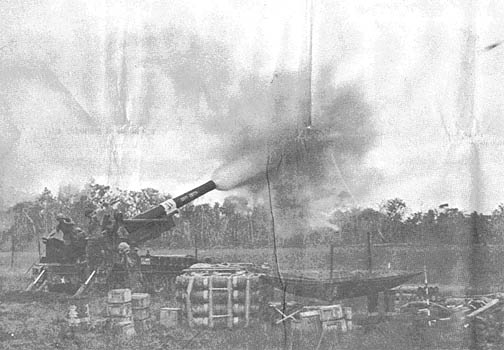 |
|
An eight-inch artillery round is hurdled toward the enemy. |
| Before the mission began an artillery survey was made. | 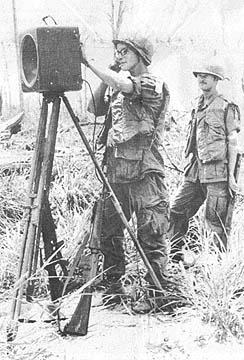 |
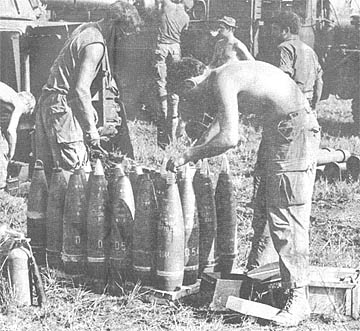 |
Delay fuses are inserted to counteract bad weather. |
| Smoke billows up around a 155mm Howitzer firing on enemy base camp. |  |
 |
|
The large raid required that vast supplies of ammunition be moved forward. |
Page 6 TROPIC LIGHTNING NEWS June 22, 1970
‘This place was out of sight’
3-Deuce Gets Good Look at Cambodia
By SP4 FRANK H. SALERNO
NEAR KREK AIR FIELD, Cambodia - Electric lights, air conditioners,
push-out windows, fine china and a Mercedes Benz. Sounds like America?
Yes, but it’s actually Cambodia.
When the 25th Division’s 2nd Battalion (Mech.), 22nd Infantry,
entered Cambodia recently to begin their operations, they discovered that there
were many things about the country that were different from South Vietnam.
“The most striking thing about the country was the extensive use
of electricity,” said Private First Class Rocco Pesolo, a rifleman of Alfa
Company, from Chicago. “Even the most remote village had power lines
running into them from main lines.”
All of the houses were built on stilts because of rainy season
flooding. All had wooden walls and doors and tin roofs as compared to the
thatch-roofed and mud-walled hootches that are prevalent in Vietnam.
“The people parked their motor scooters under the houses, not in
them as in ‘Nam,” said Specialist 4 Dan Jacobs, Bravo Company Squad Leader,
from Niles, Mich.
The houses were well-built frame-types, employing pegs, nails,
interlocking studs and snug-fitting wall boards. Many had push-out
windows.
“The houses are built to last and won’t tumble down in
storms,” said Sergeant Gary Huitt, of Bravo Company, from Perry, Iowa. “They’re pretty water-tight too.”
Inside the houses many of the people use fine chinaware to eat
from, and. the china cabinet is the prized possession of each family.
“It seemed as though the wealth of the Cambodian family is kept
in its china cabinet,” said Sergeant Robert Butters, of Bravo Company, from
Bradford, Pa.
There were many plantation homes in Cambodia, and all were very
elaborate. They were solidly constructed of brick and concrete and had
stone roofs.
“One had a room that was air-conditioned and a polished stone
floor that I could see my reflection in,” said Private First Class Joe Suemegi,
of Alfa Company, from Chicago. “Outside, there was a shiny, black
Mercedes Benz. I mean this place was out of sight!”
|
ILIKAI EAST BY NIGHT: |
||||
|
Three Strikes and ‘Ur Out-on an AP
By SP4 GREG DUNCAN
CU CHI - Mixed cheers and boos arose from the crowd as the sergeant
major fanned another batter and waited for his next victim’s entrance into the
batter’s box. It was softball in the 2nd Battalion, 27th Infantry area
at Cu Chi base camp.
The whole thing started when Charlie Company commander, Captain
Paul Evans, of Columbus, Ga., told his men that they would play a softball game
to determine which platoons would be assigned that night’s recon patrols.
While the players were taking their batting practice and the
pitchers were warming up, a standing-room-only crowd gathered along the
sidewalks of the headquarters area.
After seven furious innings and a few embarrassing errors, the
second and mortar platoons had triumphed over the first and third platoons, who
consequently pulled that night’s patrols.
Since that first game, the baseball fever has been spreading around
the Wolfhound area. And although the losers no longer go on the night
recon patrols, everybody still likes to win.
“It’s kind of hard to believe how everyone is getting involved
in the games, and the enthusiasm that’s being shown,” said Specialist 4 Jim
Baresich from Queens, N.Y., a member of Bravo Company. “I think it’s
especially helpful to the line companies,” he added.
Along with the softball games, a volleyball game can be seen going
on almost every night.
“When you’re having fun with all your buddies, it makes life a
little easier and the days seem a little shorter,” said Specialist 4 Steve St.
Sauver, from St. Paul, Minn., a catcher on the Headquarters Company team.
Dog’s Day And Steak
By SGT TIM WHALEN
TAY NINH - Dogs have their day too.
“Poncho,” a scout dog
for the 46th Infantry Scout dog Platoon, has been named “Dog of the Month.”
Every month one dog is given this title for outstanding performance.
Specialist 4 Lee Farrell from Ft. Walton Beach, Fla., was the
dog’s handler. Together, “Poncho” and Farrell found an enemy bunker
complex. Also found were two enemy soldiers.
Farrell and “Poncho” came to Vietnam six months ago, and have
been on 63 missions together. The average number of missions for a scout
dog team for one year in Vietnam is 90.
At the award ceremony Colonel Paul J. Mueller Jr., 1st Brigade
commanding officer, awarded “Poncho” with a raw steak. Specialist
Farrell was awarded a three day pass.
When asked how the missions are, “Poncho” replied, “ruff.”
Ask SGT Certain
DEAR SGT CERTAIN: I understand that it is possible to make pizza from an
array of C rations. If so, do you have the recipe?
Giovani Filipini
DEAR GIOVANI: After a comprehensive study in my bunker workshop, I think I
have come up with a recipe that will suit your taste. Get hold of a clean
M-60 ammo box and remove the top. Set it on its side and place about half
a stick of C-4 inside. Get a can of white bread and work it around in your
hands until it becomes doughy (which doesn’t take long in this climate).
After cleaning the top of the ammo box, lay out the dough on its top in the
traditional pizza pattern. Now grab a can of Beef Spices and spread the
Tomato sauce only on top of the dough. Just top off the pizza with a can
of cheese from a B-2 unit and light the C-4. Cook until the bottom of the
crust is brown. Garner with your favorite Tobasco Sauce or Nuc Mam.
DEAR SGT CERTAIN: Is it true that you really don’t exist but are only
part of a vast plot to overthrow the Tropic Lightning News and establish a
coalition editorship with the Viet Cong?
Worried
DEAR WORRIED: Balderdash. I am now, always have been and will continue to
be exactly what I was.
Page 7 TROPIC LIGHTNING NEWS June 22, 1970
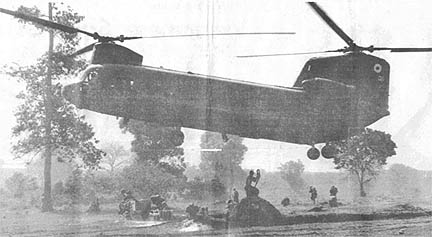 |
| RICE EVACUATION -- Rice caches were among the most plentiful finds of the Tomahawks of 4th Battalion, 23rd Infantry, working in Cambodia. The rice was hauled out on tracks or by chopper. |
Story and Photos by SGT Bill Oberholzer
MEMUT, Cambodia - The commander of the 4th Battalion (Mech.), 23rd
Infantry, recently expressed pleasure over the success of operations by his unit
inside Cambodia.
“I’m pleased with our progress,” said Lieutenant Colonel
Edward Bradford of Vienna, Va. “Our primary goal is uncovering caches
and we’ve been successful thus far.”
The “Tomahawks” have used the mobility of their unit to cover a
large area of operations centered around the Cambodian City of Memut. They
have uncovered large caches of rice, clothing, documents and armaments.
Operations began in the area, supported from Katum, in mid-May.
|
|
Page 8 TROPIC LIGHTNING NEWS June 22, 1970
 |
| PROUD RECIPIENTS -- Major General Edward M. Bautz recently presented Mr. Do Van Cu (Left) and Mr. Huynh Van Kiem the 25th Division’s Honorary Membership Scroll for their actions in rescuing a 25th Division sergeant from a chopper which crashed in the Saigon River. (Photo by SP5 Ed Drinkard) |
Win Place in 25th Division
Vietnamese Save GI
By SP5 ED DRINKARD
BIEN HOA PROVINCE - The young fisherman was busily attending to his
daily chores when he saw an American helicopter strike a power line and begin
plummeting into the Saigon River.
Running to the river bank, he saw two American soldiers hopelessly
struggling to stay afloat in the whirlpool caused by the sinking chopper.
The young Vietnamese immediately took his small sampan and hurried to the aide
of the distressed soldiers.
One of the GIs had already become a victim of the murky river.
It was up to the fisherman to save the surviving American.
Maneuvering his sampan to the lone GI, the young man steadied his
craft and pulled the soldier to the safety of his small boat.
An old man standing near the river and seeing what the young man
had just done, realized that the sampan could not be maneuvered back to shore
carrying both men. He quickly took his motor-boat out to them and pushed
the small craft back to the river bank.
A short time later, an American patrol boat arrived and took the
exhausted soldier to Long Binh for treatment.
Mr. Do Van Cu, the young man, and Mr. Huynh Van Kiem, both
residents of Binh My Hamlet, received the 25th Division’s Honorary Membership
Scroll for their actions.
Major General Edward Bautz, commander of the 25th Infantry
Division, welcomed the men into the division and personally thanked them for
their heroism in saving the life of Staff Sergeant Daniel P. Oullette, of
Boston, Mass., a “Tropic Lightning” soldier assigned to the 25th
Administration Company in Cu Chi.
Oullette is now recuperating in Japan and is reported to be in good
condition.
Besides receiving the scrolls, both men were given a sack of rice
-- compliments of the 25th’s Civic Action Staff.
“I did it out of kindness,” said Van Cu, of the award presented
to him.
725th Cuts Backlog
CU CHI - The fighting men of an infantry division depend upon the
efficient operation of all the equipment provided for them by the Army. It
is the job of the 725th Maintenance Battalion to make sure 25th Division
infantrymen have operable equipment at all times.
In maintenance, a piece of equipment being repaired, awaiting parts
or awaiting shipment to a more sophisticated repair facility is considered
“backlog.”
The 725th averages an extremely low backlog. In the first
four months of this year, its backlog was close to half what it was during the
same period of 1969.
The men of the maintenance battalion achieved their lowest backlog
on Feb. 21 of this year. On that date, there were only 112 pieces of
equipment “down for repairs.” This represents roughly one third of one
per cent of all the equipment in the division.
Sergeant First Class Jack W. Snyder, division material NCO from
Tell City, Ind., also pointed out that the 725th supports more armor and track
vehicles than any other maintenance battalion in the Republic of Vietnam.
|
Cool It, Newby
|
Cambodians Take GIs’ Medical Aid
By SP4 FRANK H. SALERNO
NEAR KREK AIR FIELD, Cambodia -- Twenty-Fifth Infantry Division
medics of the 2nd Battalion, 22nd Infantry, recently expressed surprise at the
willingness of Cambodian people to accept assistance from American troops.
“It surprised us that the Cambodians were willing to accept our
aid,” said Specialist 4 Jim Gruchala, a medic, from St. Louis. “We had
thought that the NVA had oriented the Cambodians not to accept aid from us.”
On this particular MEDCAP, two armored personnel carriers provided
security for the medics. The medics traveled in their own supply-laden
track.
“From my carrier, the medics’ track with its big black cross on
the side, reminded me of the mobile Red Cross clinics that you see back in the
world,” recalled Specialist 4 Gerald Selvester, of Delta Company, from Collton,
W. Va.
While the unit’s APCs set up security, the medics formed a line
for those who wanted medical treatment.
“We were surprised to see that so many of the people had soap
readily available to them,” said Sergeant Douglas Heard, another medic, from
Chicago. “Soap, along with proper bathing, prevents many skin diseases,
sores and rashes.”
During the afternoon, the medics treated well over 50 Cambodians.
“The MEDCAP lasted the entire afternoon and it sure was great to
see all those whom we treated wave to us as we headed back to our night laager
position,” Heard added.
AOs Named After Wives
FSB HARRON, Cambodia - Three officers of the 25th Division’s 1st
Battalion, 27th Infantry, “Wolfhounds,” had special reason for wanting their
mission in Cambodia to be successful.
The area of operations was named Jeannie after the wives of
battalion commander Lieutenant Colonel Marvin Rosenstein of Chicago and
artillery liaison officer Captain Michael Steven Moseley of Moorestown, N.J.
The Fire Support Base, Sharron, was named for the wife of
operations officer Major Robert O. Schreer of Columbus, Ga.
 |
| BRINGING SMOKE - Smoke pours from the barrel of a 105mm howitzer as members of Charlie Battery, 1st Battalion, 8th Field Artillery, support elements of the 2nd Battalion (Mech.), 22nd Infantry, inside Cambodia. (Photo by SGT Raymond Pompilio) |
Thanks to
Gary Ogden, 2nd Bn., 22nd Inf. for sharing this issue,
Kirk Ramsey, 2nd Bn., 14th Inf. for creating this page.
This page last modified 8-12-2004
©2004 25th Infantry Division Association. All rights reserved.